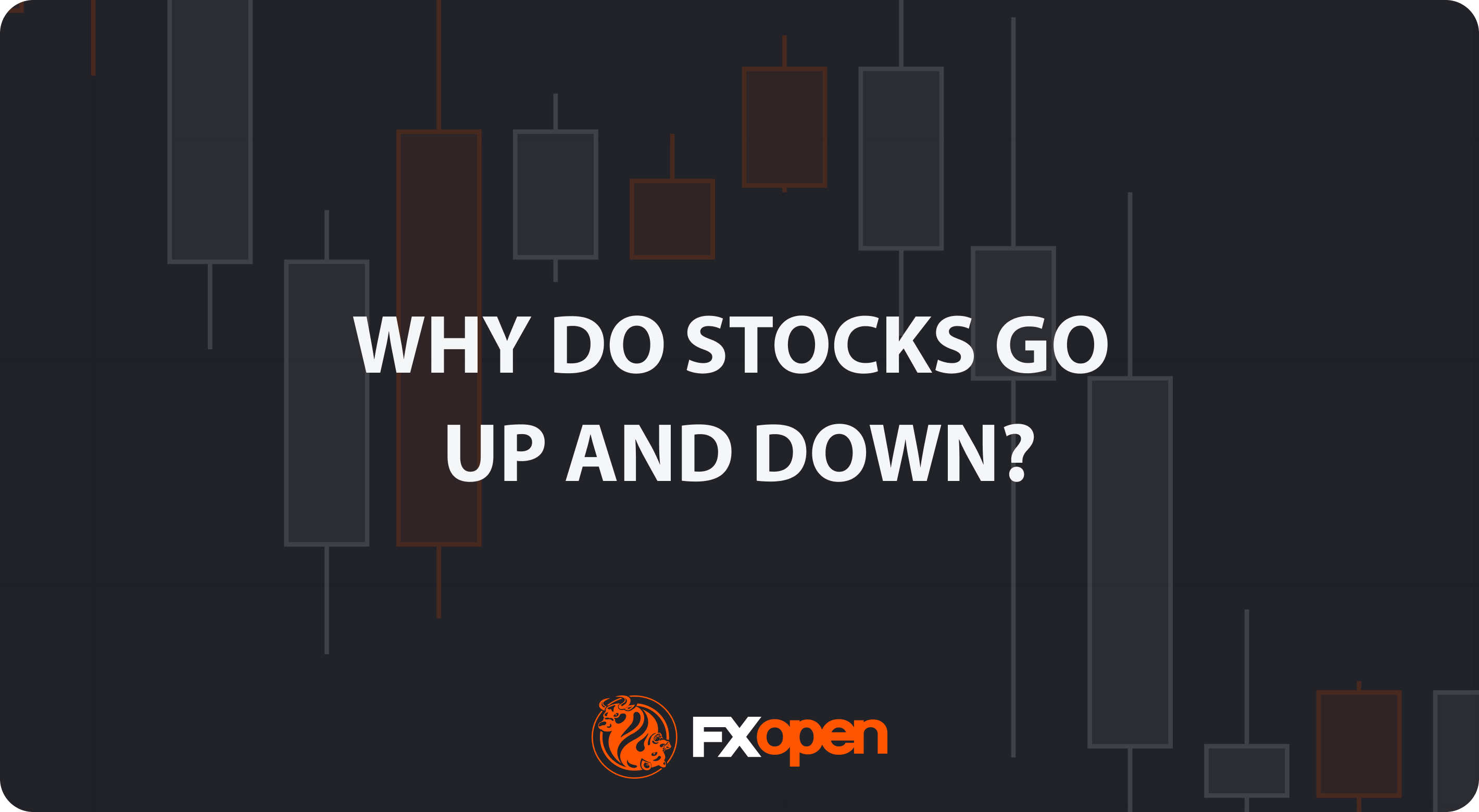FXOpen

Despite their simplicity, moving average (MA) trading strategies remain popular with experienced traders looking to refine their market analysis. This article delves into various MA types and four advanced MA strategies, including moving average ribbons, envelopes, and channels, providing actionable insights to potentially boost trading performance.
Moving Average Indicators: Advanced Types
This is a short overview of moving averages (MAs). If you already know this, please scroll down and learn advanced types of MAs and comprehensive trading strategies.
Moving averages are fundamental tools used by traders to smooth out price data and identify trends. By averaging the price over a specified period, MAs help traders filter out the noise from random price fluctuations, providing a clearer picture of the underlying market direction.
Traders use moving averages in various ways, such as determining trend direction, identifying potential support and resistance levels, and confirming other technical indicators. They can also help in spotting reversals and momentum changes. Below are the most notable moving averages that traders can use to construct a strategy.
To see how each works, head over to FXOpen’s free TickTrader trading platform to explore every tool described here and a world of more than 1,200 trading tools.
Types of Moving Averages
Simple Moving Average (SMA)
- Overview: The SMA calculates the average of a selected range of prices, typically closing prices, over a specific period.
- Usage: SMA trading is straightforward. The Simple Moving Average helps traders identify the direction of the trend by smoothing out short-term fluctuations.
Exponential Moving Average (EMA)
- Overview: The EMA gives more weight to recent prices, making it more responsive to new information.
- Usage: It reacts more quickly to price changes than the SMA, which can be beneficial in fast-moving markets.
Weighted Moving Average (WMA)
- Overview: The WMA assigns different weights to data points, with the most recent prices typically given more importance.
- Usage: Like the EMA, it reduces lag but in a slightly different manner by linearly increasing the weight of each successive data point.
Volume-Weighted Moving Average (VWMA)
- Overview: The VWMA takes volume into account, giving more weight to price points with higher trading volumes.
- Usage: Useful in identifying price moves that are supported by high trading volumes, which can indicate stronger trends.
Hull Moving Average (HMA)
- Overview: The HMA aims to improve smoothness and responsiveness to the latest data. It’s calculated using a combination of WMAs.
- Usage: Known for its responsiveness and reduced lag, making it a favourite for trend analysis.
Arnaud Legoux Moving Average (ALMA)
- Overview: The ALMA uses a Gaussian distribution to smooth data, reducing lag and improving the reliability of signals.
- Usage: It's designed to provide a balance between smoothness and responsiveness.
Volume-Weighted Average Price (VWAP)
- Overview: The VWAP calculation is based on volume and price. The indicator reflects the average price a security has traded at throughout the day.
- Usage: Widely used by institutional traders, VWAP helps determine the true average price of a security over a given period. It is crucial for understanding the market's intraday trend and for executing large orders efficiently without distorting the price.
Advanced Moving Average Indicators
Moving Average Ribbons
- Overview: This involves plotting multiple moving averages of different lengths on the same chart. The Guppy Multiple Moving Average (GMMA) is a popular example, using short-term and long-term MAs to analyse market behaviour.
- Usage: The spacing and interaction between these ribbons can indicate the strength and direction of a trend. Converging/tightening ribbons may signal a trend reversal while diverging/widening ribbons indicate a strong trend.
Moving Average Envelopes
- Overview: Envelopes consist of two bands plotted at a fixed percentage distance above and below a moving average (e.g., 2%).
- Usage: They help identify overbought and oversold conditions. Price movement outside the envelopes can indicate potential reversal points or the start of strong trends.
Moving Average Channels
- Overview: Channels are created by plotting a moving average of the highs and a moving average of the lows over a specified period.
- Usage: Traders use these channels to identify breakouts and confirm trends. Breakouts beyond the channel may signal the beginning of a new trend.
Four Advanced Moving Average Trading Strategies
Here are four advanced moving average trading strategies. You can test other settings to make the strategies more suitable for your trading approach and the timeframe you trade on.
Moving Average Ribbon Strategy
The Moving Average Ribbon Strategy leverages the Guppy Multiple Moving Averages (GMMA) alongside the ADX to identify potential breakout points. This strategy works by observing the convergence and divergence of multiple MAs to pinpoint moments of price compression and subsequent breakout, enhanced by confirming the trend strength with the ADX.
Indicators Used
- Guppy Multiple Moving Averages (GMMA): This indicator uses a series of short-term and long-term moving averages. The short-term MAs are sensitive to recent price changes, while the long-term MAs help identify the overall trend.
- Average Directional Index (ADX): This measures the strength of a trend, with values above 20 indicating a strong trend.
Entry
- Traders typically look for the long-term MAs in the GMMA (red) to converge and tighten, indicating a compressed range.
- Then they look for the price to break away from the long-term MAs with a series of closes beyond the short-term MAs - below in the downturn and above in the uptrend. Ideally, these are strong closes with minimal wicks, but a series of candles in the projected direction suffice.
- The price should remain beyond both the short-term and long-term MAs.
- The ADX should be above 20 and rising, indicating strong trending conditions. It shouldn’t be stalling or declining. Sometimes, the ADX crosses above 20 after the price has moved beyond the long-term/short-term MAs; this is also valid.
- Once these criteria are met, traders enter with a market order.
Stop Loss
- Stop loss is commonly set beyond the long-term MAs. This provides a buffer against minor fluctuations and potentially protects against false breakouts.
Take Profit
- Profits might be taken at key support or resistance levels.
- Alternatively, traders might look for the price to close beyond the short-term MAs in the opposite direction (e.g., a bullish close above the MAs in a short trade).
- A trailing stop loss positioned beyond the long-term MAs can also be used to capture sustained trends while potentially protecting gains.
Moving Average Envelopes Strategy
The Moving Average Envelopes Strategy leverages the EMA envelopes to identify potential reversal points by examining price interactions with the upper and lower bands. When combined with RSI, this stock and forex moving average strategy helps traders pinpoint overbought and oversold conditions, offering a robust method for trading reversals.
Indicators Used:
- Moving Average Envelopes: Uses an exponential moving average (EMA) set to a length of 20. The envelope percentage is adjusted based on asset volatility: 0.25%-0.5% for forex and 1%-2% for stocks might be good starting points, with a lower percentage creating more frequent opportunities but with greater false signals and vice versa. It forms an upper and lower band alongside a central EMA, similar to Bollinger Bands.
- Relative Strength Index (RSI): Set to a standard length of 14, indicating overbought conditions above 70 and oversold conditions below 30.
Entry
- Traders typically observe when the price crosses the moving average envelope bands, either upper or lower. Ideally, the price wicks through and then closes back inside the boundary, but sustained price action beyond these levels is also considered valid.
- The RSI should be above 70 for a potential short entry, indicating overbought conditions, or below 30 for a potential long entry, indicating oversold conditions.
- An entry might be made once the RSI crosses back into the normal range (between 70 and 30) and the price closes back inside of the bands.
Stop Loss
- Stop losses are generally set beyond the most recent swing point to potentially provide a buffer against minor fluctuations.
Take Profit
Profits might be taken at multiple points:
- The centerline EMA, which acts as a mean reversion target. This is the smallest target, which may be insufficient when considering the risk/reward ratio.
- The opposite envelope bound, capitalising on the price's full range movement.
- Significant support or resistance levels, providing predefined exit points.
- When the RSI crosses into the opposite territory (e.g., from overbought to oversold), indicating a potential reversal in the opposite direction.
Strategy with Three MAs
The strategy with three MAs combines the Hull Moving Averages (HMA) with the Commodity Channel Index (CCI) to identify potential trading opportunities. This strategy leverages the smoothness and responsiveness of the HMA and the momentum indications provided by the CCI to capture effective trade entries and exits.
Indicators Used
- Hull Moving Averages (HMA): Three HMAs with lengths of 13, 36, and 100.
- Commodity Channel Index (CCI): A momentum-based oscillator set to a standard length of 20. The CCI measures the difference between the current price and its average over a given period.
Entry
- Traders look for the price to be above the 100-period HMA for long positions and below it for short positions.
- Simultaneously, the CCI should be above 100 for long entries, indicating strong upward momentum, and below -100 for short entries, indicating strong downward momentum.
- Traders then watch for the 13-period HMA to cross above the 36-period HMA for long positions or below it for short positions. It should ideally be the first crossover after the price moves above or below the 100-period HMA. Occasionally, the CCI may move above 100 or below -100 shortly after this crossover occurs rather than before.
- Once these criteria are met, they enter with a market order.
Stop Loss
- Stop losses are typically set just beyond the 36-period HMA.
- Alternatively, traders may choose the 100-period EMA or a recent swing point.
Take Profit
- Profits might be taken once the price crosses back over the 100-period HMA, signalling a potential end to the current trend.
- Alternatively, traders may choose to take profits at significant support or resistance levels, providing predefined exit points based on market structure.
Moving Average Channel Strategy
The Moving Average Channel Strategy utilises the Moving Average Channel along with the Parabolic SAR and ADX to identify potential trading opportunities. This strategy helps traders capture breakouts by confirming trend strength and potential reversals, offering a robust approach to trading trending markets.
Indicators Used
- Moving Average Channel: Set to a length of 50, this channel uses the moving averages of the highs and lows to create two lines, forming a channel around the price.
- Parabolic SAR: An indicator that plots dots above or below the price to signal potential reversals.
- Average Directional Index (ADX): Measures the strength of a trend, with values above 20 indicating a strong trend.
Entry
- Traders look for the price to trade through the Moving Average Channel, either breaking from above to below (for a downtrend) or from below to above (for an uptrend), ideally with a series of strong candles.
- Simultaneously, the Parabolic SAR should plot dots above the price, indicating a bearish signal, and vice versa.
- The ADX should be above 20 and rising, not stalling or declining, confirming a strong and growing trend.
- All three signals (price breaking through the channel, Parabolic SAR, and ADX above 20 and rising) should occur relatively close to each other, typically within a few candles.
- Once all criteria are met, traders enter.
Stop Loss
- Stop losses are typically set just beyond the Moving Average Channel or at a nearby swing point.
Take Profit
- Profits might be taken when the price closes back through the other side of the Moving Average Channel, signalling a potential trend reversal. In this scenario, there is a risk of missing a part of potential profits in the solid trend.
- Alternatively, traders might choose to take profits at significant support or resistance levels, providing predefined exit points based on market structure.
Best Practices for Using Moving Average Indicators
Moving average indicators are essential tools in technical analysis. Here are some best practices to maximise their effectiveness:
Choosing the Right Type
Selecting the appropriate type of moving average is crucial. For example, an EMA is more responsive to recent price changes, making it suitable for short-term trading, while an SMA may be better for long-term trend analysis.
Choosing Suitable Lengths
It’s best to use a combination of short-term and long-term moving averages to get a comprehensive view of the market. For instance, combining a 20-day, 50-day, and 200-day moving average can help in identifying both short-term fluctuations and long-term trends.
Experimenting
There are various moving average types beyond the well-known SMA and EMA, such as the Hull Moving Average (HMA), Volume Weighted Moving Average (VWMA), and more. Experimenting with different types can help you find the best fit for your MA strategy.
Combining with Other Analysis
You can potentially enhance your moving average strategy by combining it with other forms of analysis and indicators, such as those described in the strategies above. This will allow you to confirm signals and get a more comprehensive market picture.
Backtesting and Forward Testing
Before deploying any moving average strategy in real-time, traders typically backtest it with historical data to understand its performance under different market conditions. Then, when transitioning from backtesting to live trading, they forward test with a demo account to refine their strategy without risking real money.
Beware of False Signals
Moving average crossovers in choppy markets can generate false signals. Consider additional filters, such as trend confirmation from the ADX, to avoid whipsaws.
Following these best practices can help you effectively incorporate moving averages into your trading strategies, whether you're using a moving average crossover strategy or an EMA trading strategy.
The Bottom Line
Advanced moving average strategies can offer a route to potentially enhance your trading analysis and performance. As always, it’s best to experiment with different indicators and backtest strategies to find what works best. To start implementing these strategies, consider opening an FXOpen account. Use our robust tools and enjoy low commissions and tight spreads from 0.0 pips.
FAQs
How to Use Moving Averages?
Moving averages smooth out price data, helping to identify trends and potential support/resistance levels. Traders often use moving averages to determine trend direction, confirm breakouts, and identify reversals. Combining short-term and long-term moving averages provides a well-rounded market overview. For instance, a simple SMA strategy might see a trader watch for a crossover between a pair of long and short-term SMAs before entering.
What Is the Simple Moving Average?
The Simple Moving Average represents an asset’s average price over a specified period. It's a fundamental tool in trading, smoothing out fluctuations to highlight the underlying trend. An SMA trading strategy typically involves comparing SMAs of different lengths to identify crossovers and trend changes.
What Does EMA Stand For in Trading?
The EMA stands for the Exponential Moving Average. Unlike the SMA, the EMA gives more weight to recent prices, making it more responsive to price changes. This responsiveness makes the EMA popular in strategies that require quick reaction to market movements, such as an EMA crossover strategy.
What Moving Average Should Be Used for Day Trading?
In moving averages for day trading, shorter periods like the 9 or 21 are often used due to their responsiveness to recent price changes. These shorter EMAs help day traders quickly identify trend direction and potential entry/exit points.
This article represents the opinion of the Companies operating under the FXOpen brand only. It is not to be construed as an offer, solicitation, or recommendation with respect to products and services provided by the Companies operating under the FXOpen brand, nor is it to be considered financial advice.
Stay ahead of the market!
Subscribe now to our mailing list and receive the latest market news and insights delivered directly to your inbox.








